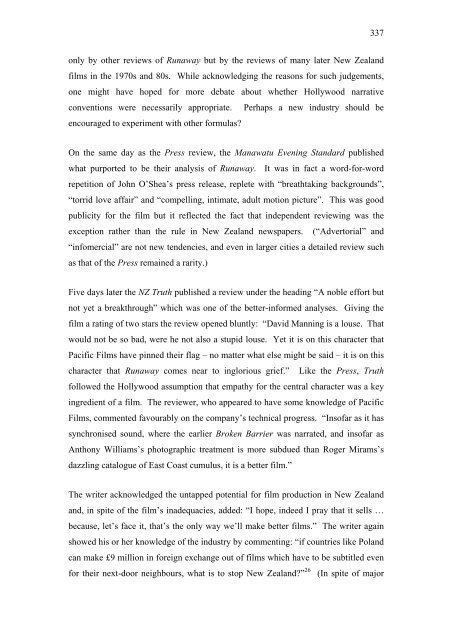Copyright Statement - ResearchSpace@Auckland
Copyright Statement - ResearchSpace@Auckland
Copyright Statement - ResearchSpace@Auckland
Create successful ePaper yourself
Turn your PDF publications into a flip-book with our unique Google optimized e-Paper software.
337<br />
only by other reviews of Runaway but by the reviews of many later New Zealand<br />
films in the 1970s and 80s. While acknowledging the reasons for such judgements,<br />
one might have hoped for more debate about whether Hollywood narrative<br />
conventions were necessarily appropriate. Perhaps a new industry should be<br />
encouraged to experiment with other formulas?<br />
On the same day as the Press review, the Manawatu Evening Standard published<br />
what purported to be their analysis of Runaway. It was in fact a word-for-word<br />
repetition of John O’Shea’s press release, replete with “breathtaking backgrounds”,<br />
“torrid love affair” and “compelling, intimate, adult motion picture”. This was good<br />
publicity for the film but it reflected the fact that independent reviewing was the<br />
exception rather than the rule in New Zealand newspapers. (“Advertorial” and<br />
“infomercial” are not new tendencies, and even in larger cities a detailed review such<br />
as that of the Press remained a rarity.)<br />
Five days later the NZ Truth published a review under the heading “A noble effort but<br />
not yet a breakthrough” which was one of the better-informed analyses. Giving the<br />
film a rating of two stars the review opened bluntly: “David Manning is a louse. That<br />
would not be so bad, were he not also a stupid louse. Yet it is on this character that<br />
Pacific Films have pinned their flag – no matter what else might be said – it is on this<br />
character that Runaway comes near to inglorious grief.” Like the Press, Truth<br />
followed the Hollywood assumption that empathy for the central character was a key<br />
ingredient of a film. The reviewer, who appeared to have some knowledge of Pacific<br />
Films, commented favourably on the company’s technical progress. “Insofar as it has<br />
synchronised sound, where the earlier Broken Barrier was narrated, and insofar as<br />
Anthony Williams’s photographic treatment is more subdued than Roger Mirams’s<br />
dazzling catalogue of East Coast cumulus, it is a better film.”<br />
The writer acknowledged the untapped potential for film production in New Zealand<br />
and, in spite of the film’s inadequacies, added: “I hope, indeed I pray that it sells …<br />
because, let’s face it, that’s the only way we’ll make better films.” The writer again<br />
showed his or her knowledge of the industry by commenting: “if countries like Poland<br />
can make £9 million in foreign exchange out of films which have to be subtitled even<br />
for their next-door neighbours, what is to stop New Zealand?” 26 (In spite of major















